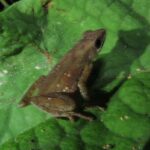- Meet Callulina laphami: Tanzania's Forest Jewel and Conservation Priority
- Taxonomy and Classification: Understanding Its Amphibian Lineage
- The Misty Mountain Realm: Natural Habitat of <em>Callulina laphami</em>
- An Intimate Portrait: Physical Characteristics and Adaptations
- A Secretive Lifestyle: Behavior and Life Cycle of the Tanzania’s Forest Jewel
- The Hidden Giant: Ecological Importance Within Forest Ecosystems
- At the Threshold of Survival: Threats and Conservation Status
- Cultural and Scientific Significance: Illuminating Life on Our Shared Earth
- Embracing Tanzania’s Forest Jewel: Our Shared Responsibility
Meet Callulina laphami: Tanzania’s Forest Jewel and Conservation Priority#
Hidden deep within the verdant montane forests of Tanzania lives an enigmatic and mesmerizing little amphibian, casting its small yet significant shadow over the forest floor. Known scientifically as Callulina laphami, this delicately patterned frog embodies the vibrant biodiversity of East Africa’s mountainous heartland. While tiny and secretive, its very existence serves as an ecological pulse, indicative of the forest’s health and vitality. Beautiful yet vulnerable, mysterious yet scientifically insightful—Callulina laphami invites us to pause, listen carefully to nature’s subtle rhythms, and appreciate one of Earth’s seldom-seen amphibian wonders. Just what makes this Tanzanian frog special enough to warrant such attention? Let’s dive beneath the leafy canopy, part the curtain of mist, and venture into the fascinating world of Callulina laphami.
Taxonomy and Classification: Understanding Its Amphibian Lineage#
Taxonomically, Callulina laphami belongs to the family Brevicipitidae, comprising small-bodied, terrestrial frogs primarily native to Africa’s moist forests and mountains. As a member of the genus Callulina, this species shares characteristic traits such as compact body shapes, distinctive vocalizations, and an affinity for concealed microhabitats. Described scientifically for the first time in 2010, the discovery of Callulina laphami underscored the rich yet partially-unknown biodiversity still hidden within African rainforests and highlands.
This species is named in honor of Dr. Lewis H. Lapham, recognizing his contributions to conservation efforts in Tanzania. Its close relatives—including other members of genus Callulina—occupy similar ecological niches across mountainous terrains, serving as important biological indicators of environmental health. Because of their limited range and specialization, these frogs are fascinating subjects for herpetological study, highlighting both evolutionary processes and ecological interconnectedness.
The Misty Mountain Realm: Natural Habitat of Callulina laphami#
To encounter Callulina laphami in its lush home, one must climb the moist, mist-enshrouded slopes of Tanzania’s Eastern Arc Mountains, particularly within the Pare Mountains. Here, at elevations ranging typically between 1,800 to 2,200 meters above sea level, one finds the cool, damp montane rainforests where this frog thrives. In this habitat, time moves more slowly; clouds drift silently between trees draped in moss, and an intricate canopy shelters a myriad of wildlife below.
Callulina laphami demonstrates highly specialized habitat preferences. Rather than residing near water bodies—a common expectation for amphibians—this frog selects a cryptic terrestrial lifestyle, inhabiting leaf litter, moss-covered logs, rock crevices, and dense undergrowth. Such microhabitats provide critical moisture, allowing this species to breathe and protect its permeable skin from desiccation. Carefully adapted to this niche, Callulina laphami is thus vulnerable to even the slightest habitat disruptions.
The richness of the forest, with its perpetual mist layer and abundant rainfall, helps maintain humidity levels crucial to this frog’s survival. Moreover, the forest offers abundant food supply, from tiny insects to soil-dwelling invertebrates, ensuring these secretive amphibians are rarely without nourishment.
An Intimate Portrait: Physical Characteristics and Adaptations#
Observing Callulina laphami up close reveals an amphibian of striking subtlety. Adults generally measure between two and three centimeters in length, making them diminutive yet eye-catching inhabitants of their micro-scale environment. A robust, compact body adorned with slightly granular skin characterizes this earthy-hued frog, spanning shades of tan to reddish-brown, intermixed with darker mottling—a camouflage masterpiece blending seamlessly with the leaf-litter floor.
The frog’s limbs, relatively short and muscular, are purpose-built for a terrestrial lifestyle, allowing it to maneuver efficiently through soil, leaf cover, and organic debris. Unlike frogs that leap or swim vigorously, Callulina laphami often prefers a more deliberate locomotion, carefully creeping through its habitat. This deliberate movement helps conserve energy, enhances precision hunting, and allows the frog to remain nearly invisible to predators.
Its rounded snout is adapted perfectly for probing into small crevices in search of insect prey. Large, expressive eyes provide excellent nocturnal vision, enabling successful hunting during twilight and nighttime hours. The skin, as characteristic of most amphibians, remains moist and serves as a critical respiratory organ through cutaneous respiration—exchanging vital gases directly with its misty surroundings.
A Secretive Lifestyle: Behavior and Life Cycle of the Tanzania’s Forest Jewel#
Feeding Habits and Predation Techniques#
When twilight descends and the rains lightly patter down onto the cool forest floor, Callulina laphami stirs from daytime concealment, eager to exploit the nighttime abundance. Foraging quietly among layers of moist foliage, moss, and fallen debris, the frog hunts primarily small arthropods such as ants, beetles, springtails, termites, and mites. Using its acute nocturnal vision, it skillfully targets prey, extending a swift tongue to ensnare insects with remarkable precision. Its eating habits not only showcase impressive hunting skill but also underscore its ecological utility in controlling insect populations beneath this mountain forest’s delicate canopy ecosystem.
Breeding and Reproductive Strategies#
Perhaps one of Callulina laphami‘s most intriguing traits lies within its reproductive behavior. Unlike many amphibians, this frog engages in direct development—a remarkable adaptation that permits it to forego the aquatic tadpole stage completely. Females produce just a handful of eggs, usually deposited in damp, concealed sites like soil depressions or cavities in mossy debris, from which fully-formed miniatures of adult frogs hatch directly.
This evolutionary adaptation alleviates the necessity of aquatic habitats in mountainous terrains, where standing water sources are often scarce. Instead, maternal investment occurs through meticulous placement of eggs in suitably moist micro-conditions. Young frogs then emerge, fully terrestrial and ready to face forest life immediately, thus maximizing their survival prospects in the complex, predator-filled mountain forest environment.
The Hidden Giant: Ecological Importance Within Forest Ecosystems#
Though tiny, the ecological role Callulina laphami plays is disproportionately large and significant. Occupying a central position in the lower food web, this frog helps regulate populations of numerous insect species, maintaining balance within the intricate web of forest life. Furthermore, being preyed upon by terrestrial predators such as birds, small mammals, and reptiles positions them crucially as an important food source within the biodiversity-rich Pare Mountain ecosystems.
Moreover, due to their sensitivity to environmental fluctuations and habitat degradation, this species serves as a potent indicator species. Their population health—decline or thrive—offers invaluable clues regarding the organisms’ broader ecosystem functioning and highlights the status of biodiversity in these fragile montane regions.
At the Threshold of Survival: Threats and Conservation Status#
Despite their specialized adaptations, these little frogs face massive challenges. The International Union for Conservation of Nature (IUCN) currently categorizes Callulina laphami as Critically Endangered, recognizing the perilous state of their fragmented mountain habitat. Their restricted geographic range makes them particularly vulnerable to localized disasters—logging, habitat clearance for agriculture, forest fires, and climate shifts—all of which threaten the biodiversity hotspot they call home.
Increased human settlement and unsustainable agricultural activity are particularly pressing threats, causing deforestation and ecosystem fragmentation. Conservation efforts continue, primarily driven by habitat preservation, rehabilitation, and awareness-raising among local communities about these amphibians’ significance and vulnerability. Documentation of population trends remains an urgent priority ensuring informed conservation planning.
Cultural and Scientific Significance: Illuminating Life on Our Shared Earth#
While perhaps less recognized culturally than iconic megafauna, Callulina laphami nevertheless reveals extraordinary insights into evolutionary adaptation, ecology, and biodiversity health. Scientists studying these creatures unravel crucial data about amphibian conservation, evolutionary biology, and climate resilience.
This Tanzanian forest frog’s remarkable adaptation strategy provides invaluable templates for understanding biodiversity’s future in quickly changing environments. Their presence provokes curiosity, appreciation, and respect towards less-heralded yet ecologically irreplaceable creatures that enrich Earth’s biodiversity tapestry.
Embracing Tanzania’s Forest Jewel: Our Shared Responsibility#
As stewards entrusted with safeguarding Earth’s remarkable creatures, engaging with Callulina laphami‘s story challenges us to support meaningful conservation action. In protecting this modest yet essential frog, we preserve not merely life, but also the complex ecological balance that sustains our shared planet.







